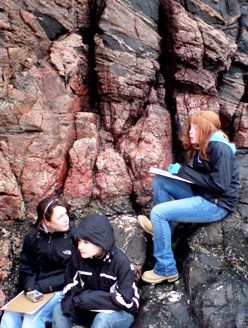Suffering for art and Earth science is still alive and well in the North West Highlands. Clare Bond took a pack of 12 and 13 year-olds up a snow-clad Foinaven – and lived.
Geoscientist Online 15 August 2007

The Northwest Highlands is celebrated as one of the birthplaces of understanding mountain building. The geologists who worked there in the late 19th Century developed the ideas behind thrust faulting and published their work in the celebrated 1907 Memoir for the area. As part of its Centenary celebrations in May 2007, I took to the Northwest Highlands not to enjoy its mountain landscape, stunning beaches, or to potter among the rocks, but to bring the excitement of the 100 year old work to the hearts and minds of the young people who live in the centre of this remote geological Mecca.
It is fair to say that I had no special background or skills to take on the challenge of combining geology and art to “make mountains” with 12 and 13 year-olds. But with support from a Royal Society Education Partnership Grant and Scottish Natural Heritage I delivered workshops in conjunction with two artists Kate Foster and Alex Wilde at Kinlochbervie and Ullapool High Schools. Over four days the young people created cross-sections, field sketches, and made observations in their field notebooks. The young geologists were enthusiastic and soon got into the observational rigour, creativity and experimentation that both geology and art have to offer. Student Joanna said “It is a good mixture because you are drawing and creating whilst learning about geology… I learnt a lot about rocks and mountains...”.
Together we made mountains using a replica of the ‘squeeze box’ that Henry Cadell had used in the late 19th Century to recreate the structure of the local mountain Foinaven (Geoscientist 14, 4-7, 2004). The thrust faults produced were accurately observed in the students' notebooks, the ‘squeeze box’ rating as the most interesting session in the workshop – good experiments are engaging even when they are rather ancient. The frigid field day (fresh snow on Foinaven in May!) was reflected in the students' comments. However the work they created while in the field and afterwards was a credit to their commitment - as well as that of their teachers Alison Wood and Murdo Macpherson, who continually enthused the students.
I hope that the students learnt about the geology of their area and its critical role in the historical development of understanding mountain building, as well as linking their observations to broader Earth science themes such as climate change, natural hazards and global cycles. What did I learn? That young people are keen to learn about Earth science; that one approach does not suit all; that hands-on doing things often helps understanding, and that experimentation, discussion, observation, and exploring ideas are all far better ways to learn than teaching "the right answer". What better subject could there be to develop those skills than Earth science?
- The work of the young people will be displayed along with reproductions of the 1880s geological maps at Our Dynamic Earth, Edinburgh July 7 –August 30 and at the Hunterian Art Gallery and Museum, Glasgow in September, for more information see www.mappingmountains.com
*Clare Bond is a Structural Geologist at Midland Valley Exploration and the University of Glasgow.